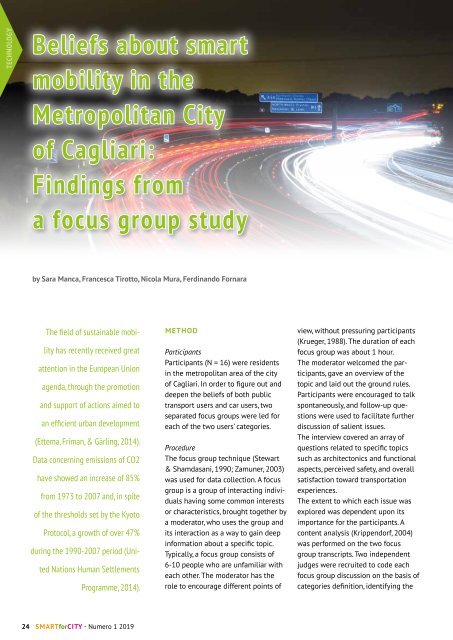SMARTforCITY Numero uno
Smart cities technologies
Smart cities technologies
Create successful ePaper yourself
Turn your PDF publications into a flip-book with our unique Google optimized e-Paper software.
TECHNOLOGY<br />
Beliefs about smart<br />
mobility in the<br />
Metropolitan City<br />
of Cagliari:<br />
Findings from<br />
a focus group study<br />
by Sara Manca, Francesca Tirotto, Nicola Mura, Ferdinando Fornara<br />
The field of sustainable mobility<br />
has recently received great<br />
attention in the European Union<br />
agenda, through the promotion<br />
and support of actions aimed to<br />
an efficient urban development<br />
(Ettema, Friman, & Gärling, 2014).<br />
Data concerning emissions of CO2<br />
have showed an increase of 85%<br />
from 1973 to 2007 and, in spite<br />
of the thresholds set by the Kyoto<br />
Protocol, a growth of over 47%<br />
during the 1990-2007 period (United<br />
Nations Human Settlements<br />
Programme, 2014).<br />
METHOD<br />
Participants<br />
Participants (N = 16) were residents<br />
in the metropolitan area of the city<br />
of Cagliari. In order to figure out and<br />
deepen the beliefs of both public<br />
transport users and car users, two<br />
separated focus groups were led for<br />
each of the two users’ categories.<br />
Procedure<br />
The focus group technique (Stewart<br />
& Shamdasani, 1990; Zamuner, 2003)<br />
was used for data collection. A focus<br />
group is a group of interacting individuals<br />
having some common interests<br />
or characteristics, brought together by<br />
a moderator, who uses the group and<br />
its interaction as a way to gain deep<br />
information about a specific topic.<br />
Typically, a focus group consists of<br />
6-10 people who are unfamiliar with<br />
each other. The moderator has the<br />
role to encourage different points of<br />
view, without pressuring participants<br />
(Krueger, 1988). The duration of each<br />
focus group was about 1 hour.<br />
The moderator welcomed the participants,<br />
gave an overview of the<br />
topic and laid out the ground rules.<br />
Participants were encouraged to talk<br />
spontaneously, and follow-up questions<br />
were used to facilitate further<br />
discussion of salient issues.<br />
The interview covered an array of<br />
questions related to specific topics<br />
such as architectonics and functional<br />
aspects, perceived safety, and overall<br />
satisfaction toward transportation<br />
experiences.<br />
The extent to which each issue was<br />
explored was dependent upon its<br />
importance for the participants. A<br />
content analysis (Krippendorf, 2004)<br />
was performed on the two focus<br />
group transcripts. Two independent<br />
judges were recruited to code each<br />
focus group discussion on the basis of<br />
categories definition, identifying the<br />
24 <strong>SMARTforCITY</strong> - <strong>Numero</strong> 1 2019


















